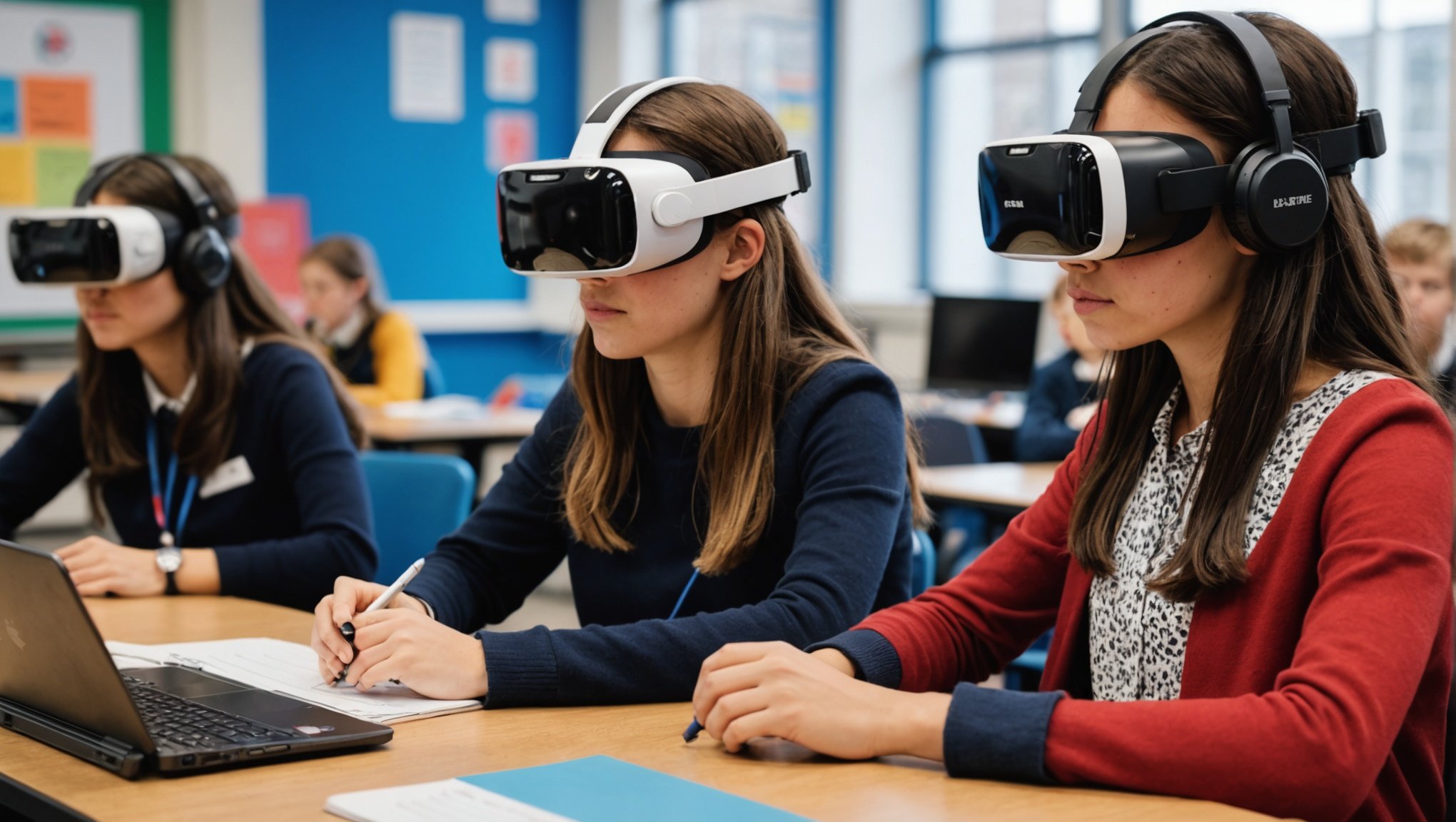Remote learning has driven educators to seek innovative solutions. Augmented Reality (AR) and Virtual Reality (VR) present unique opportunities to enhance engagement and interactivity in UK schools. These technologies can transform traditional learning environments, making lessons immersive and captivating. By integrating AR and VR into remote learning, teachers can create rich, vivid experiences that stimulate curiosity and improve comprehension. Explore how these cutting-edge tools are reshaping the educational landscape, fostering a deeper understanding of subjects while making learning a truly interactive adventure.
Overview of AR and VR Technologies in Education
Augmented Reality (AR) and Virtual Reality (VR) are transforming the educational landscape by merging digital and physical worlds. AR in education involves overlaying digital information onto the real world, enhancing the learning experience with interactive elements. For example, students can view 3D models of historical artifacts right in their classroom. VR in education, on the other hand, immerses students in entirely virtual environments, allowing them to explore scenarios like walking through ancient Rome or diving into the ocean's depths.
Additional reading : Unlocking Efficiency: Strategies for UK Manufacturers to Harness 4IR Technologies
Historically, AR and VR technologies started gaining traction in educational settings around the early 2000s, primarily in higher education and specialized training programs. Initially, their use was limited due to high costs and technological constraints. However, advancements in technology and reductions in cost have made these tools more accessible.
Current trends show a significant increase in the adoption of AR and VR technologies across various educational levels. Many schools are now integrating AR and VR into their curricula to foster a more engaging and interactive learning environment. This trend is driven by the growing recognition of the benefits these technologies bring, such as enhancing student engagement, improving retention rates, and offering personalized learning experiences. As these technologies continue to evolve, they promise to further revolutionize education.
Also read : Unlocking Efficiency: AI and Machine Learning Strategies for Optimizing Route Planning in UK Logistics
Benefits of AR and VR for Remote Learning
Incorporating AR and VR into remote learning offers distinct advantages that enhance the educational experience. One of the primary benefits of AR is its ability to boost engagement and motivation among students. By overlaying digital content onto their real-world environment, students can interact with course material in a dynamic and engaging manner. This interactivity helps maintain interest and encourages active participation.
Similarly, the benefits of VR in remote learning are profound. VR creates immersive experiences that significantly improve the retention of information. When students are placed in a fully virtual environment, they can explore complex concepts in a hands-on way, leading to deeper understanding and better recall. For example, a virtual field trip to a historical site can make history lessons more memorable.
Moreover, both AR and VR offer opportunities for personalized learning. These technologies can adapt to individual learning styles, providing customized content that caters to each student's needs. This adaptability enhances accessibility, ensuring that all students, regardless of their learning preferences or physical abilities, can benefit from these advanced educational tools. As a result, AR and VR are not just transforming how subjects are taught but are also making education more inclusive and effective in remote settings.
Successful Case Studies in UK Schools
In recent years, several UK schools have embraced AR and VR technologies, showcasing innovative applications in education. These case studies highlight the transformative impact of these technologies on teaching and learning.
One notable example is the use of AR in science classes. At a prominent secondary school in London, students interact with 3D models of complex molecules, allowing them to visualise and manipulate structures in real-time. This hands-on approach deepens understanding and fosters enthusiasm for the subject.
In the realm of history, a school in Manchester has integrated VR technology to transport students to significant historical events. By virtually walking through the trenches of World War I, students gain a visceral understanding of the conditions soldiers faced, making historical lessons more engaging and memorable.
Feedback from both students and educators in these UK schools has been overwhelmingly positive. Students report increased engagement and a better grasp of difficult concepts. Educators appreciate the ability to tailor lessons to diverse learning styles, enhancing overall educational outcomes.
These successful implementations in UK schools demonstrate the potential of AR and VR to enrich education, making learning more interactive and impactful. As these technologies continue to evolve, their role in education is likely to expand further.
Effective Strategies for Implementing AR and VR
Implementing AR and VR in educational settings requires thoughtful strategies to ensure successful integration. Here are some effective steps and practices to consider.
Steps for Integration: Begin by assessing the specific needs of your curriculum and identifying areas where AR and VR can enhance learning. Collaborate with educators to design lessons that incorporate these technologies meaningfully. Prioritise the selection of user-friendly AR and VR tools that align with educational goals.
Teacher Training and Support: Providing comprehensive training for teachers is crucial. Educators should be familiar with the technology and confident in using it to enhance their teaching methods. Ongoing support and professional development opportunities are essential, enabling teachers to stay updated with the latest advancements and best practices in AR and VR.
Tools and Resources: Utilize platforms and software specifically designed for educational purposes. Resources like CoSpaces Edu and Google Expeditions offer a range of AR and VR content that can be adapted to various subjects. Encourage collaboration among teachers to share insights and resources, fostering a community of practice.
By following these strategies, schools can effectively integrate AR and VR into their curricula, enhancing the learning experience and preparing students for a technology-driven future.
Challenges and Limitations of AR and VR in Education
Navigating the challenges of AR and VR in education involves addressing several key issues that can hinder their effective implementation. One significant challenge is the technical issues and accessibility concerns associated with these technologies. Schools often face difficulties in ensuring that the necessary hardware and software are compatible and up-to-date. Additionally, not all students have equal access to the required devices, creating disparities in learning opportunities.
Another major hurdle is the cost implications for schools and institutions. Implementing AR and VR technologies can be expensive, with costs related to purchasing equipment, software, and maintaining the infrastructure. This financial burden can be a deterrent for schools with limited budgets, making it difficult to justify the investment without clear evidence of improved educational outcomes.
Resistance from educators or stakeholders is also a prevalent issue. Some educators may be hesitant to adopt AR and VR due to a lack of familiarity or confidence in using the technology. This resistance can be compounded by a perception that these tools are more of a novelty than a necessity in education. Stakeholders might question the return on investment or the practicality of integrating such advanced technologies into traditional curricula. Addressing these concerns requires comprehensive training and demonstrating the tangible benefits of AR and VR in enhancing learning experiences.
The Role of Collaboration in AR and VR Learning
Incorporating collaborative learning in AR and VR environments enhances educational experiences by fostering teamwork and communication. These technologies provide unique opportunities for students to work together on immersive projects, promoting a deeper understanding of the material through shared experiences.
Collaborative learning in AR and VR settings often involves students engaging in group activities where they must communicate effectively to achieve common goals. For example, students might work together to solve complex problems in a virtual simulation or collaborate on creating a 3D model of a historical site. This teamwork not only aids in knowledge retention but also develops essential social skills.
In UK schools, there have been several successful collaborative AR and VR projects. One project involved students teaming up to explore a virtual reconstruction of a Roman city, requiring them to navigate and discuss the historical context collectively. Such experiences encourage students to build peer relationships and enhance their ability to work in diverse teams.
The impact of collaborative learning through AR and VR extends beyond academic achievement. It helps students improve their social skills, fostering a sense of community and belonging. By engaging in these interactive and immersive experiences, students learn to appreciate different perspectives, preparing them for future collaborative endeavors.
Future Trends in AR and VR for Education
The future of AR and VR in education promises exciting developments, driven by rapid technological advancements. As these technologies evolve, they are expected to become more integrated into everyday learning environments, offering innovative ways to engage students.
Predictions for technological advancements in AR and VR suggest that these tools will become more sophisticated and accessible. Enhanced graphics, improved user interfaces, and reduced costs will make AR and VR more appealing for educational institutions. These advancements will likely lead to the development of more immersive and interactive educational content, tailored to diverse learning needs.
Potential new applications of AR and VR in remote learning are vast. Future trends indicate that these technologies could enable real-time collaboration across different locations, allowing students to participate in shared virtual classrooms. This could revolutionize how remote education is delivered, making it more interactive and engaging.
As AR and VR technologies advance, the role of educators will evolve. Teachers will need to adapt to new teaching methods that incorporate these tools, focusing on facilitating and guiding students through immersive learning experiences. Educators will become more like mentors, helping students navigate and make the most of these innovative educational resources.
Practical Tips for Educators
Incorporating AR and VR technologies into the classroom can be a transformative experience, but it requires careful planning and execution. Here are some practical tips for using AR VR in education effectively.
Guidelines for Selecting Tools: Choose AR/VR tools that align with your educational goals and curriculum needs. Prioritize tools that are user-friendly and provide robust support for educators. Evaluate the scalability of the technology and its compatibility with existing systems in your school.
Developing Engaging Content: When creating content, focus on interactivity and relevance to student interests. Tailor experiences to be immersive and relatable, encouraging students to actively participate. Consider incorporating elements that allow students to explore and experiment, making learning both fun and educational.
Professional Development Resources: Continuous learning is crucial for educators to keep up with technological advancements. Seek out workshops, online courses, and webinars focused on AR and VR in education. Engage with communities of practice where educators share insights and experiences. This ongoing professional development ensures that teachers remain confident and competent in using these innovative tools.
By following these tips for using AR VR in education, educators can enhance their teaching methods, making learning more interactive and effective for students.
Integrating AR and VR with Other Technologies
Integrating AR and VR technologies with existing educational tools can significantly enhance the learning experience. By complementing platforms like Learning Management Systems (LMS) and video conferencing, these technologies offer a more holistic approach to education.
AR VR integration technologies can seamlessly work with LMS platforms, providing an interactive layer to traditional online courses. For instance, students can access AR-enhanced content directly through their LMS, allowing for a more engaging learning experience. This integration facilitates a blended learning approach, where digital and physical learning environments merge.
Incorporating AR and VR into video conferencing platforms transforms remote learning. Students can participate in virtual classrooms that simulate real-world environments, making lessons more immersive. This setup encourages greater interaction and collaboration among students, even when they are miles apart.
The benefits of a blended learning approach using AR and VR are numerous. It caters to diverse learning styles, offering personalized educational experiences. By integrating these technologies, educators can create a dynamic learning environment that adapts to the needs of students, making education more inclusive and effective. As AR and VR continue to evolve, their potential to revolutionize educational practices will only grow, providing exciting opportunities for both teachers and students.
Multimedia Resources for AR and VR in Education
Exploring the vast array of AR VR educational resources can significantly enhance teaching and learning experiences. These resources include a variety of educational apps and platforms designed to integrate seamlessly into the classroom.
Overview of available AR and VR educational apps and platforms:
- CoSpaces Edu: An intuitive platform that allows students to create and explore their own virtual worlds, enhancing creativity and critical thinking.
- Google Expeditions: Offers immersive virtual field trips, enabling students to explore distant places without leaving the classroom.
- Merge Cube: A handheld device that brings 3D objects to life, providing interactive learning experiences.
Recommended online courses and webinars for teachers:
- Educators can benefit from resources like Coursera and edX, which offer courses on implementing AR and VR in educational settings.
- Webinars hosted by organizations such as ISTE provide insights into the latest trends and best practices in AR VR education.
Curated list of research and articles on AR/VR in education:
- Academic journals like the Journal of Educational Technology & Society offer peer-reviewed articles that delve into the efficacy and impact of AR and VR in educational contexts.
- Online platforms like ResearchGate provide access to a wealth of studies and papers, facilitating educators' understanding of these technologies' potential.











